A few weeks ago I introduced a new quilt I’m working on. For now I’m calling “him” Oscar the Marabou stork. (Feel free to submit more formal title ideas in the comments below.) As I said previously, this piece will be part of an eleven-quilt show entitled “Specimens” that will debut at the International Quilt Festival in Houston this November.
Oscar is progressing nicely, I think, considering it’s summer in Maine and there are so many distractions. Camping, kayaking, hiking, gardening—we have to cram all the best outdoor activities into a precious few months.
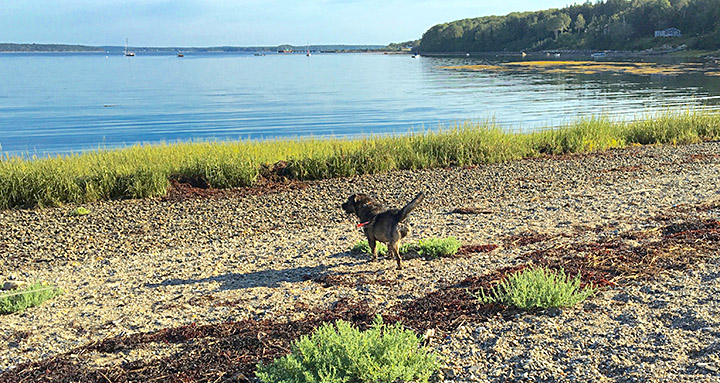

I was totally inspired by the colors I chose to begin with, the yellows and oranges of the neck and head. Not totally realistic, but when has that stopped me before? Then, for the chest and wing fabrics, I went for value. Light values of cream, yellow, pale green, blue, and grey in contrast with dark values of black, brown, red, plus dark green, blue, and grey.
If you remember, I’m working exclusively from scraps—little pieces of fabric left over from previous quilts or even gifted to me from students. It’s been a few years since I worked this way. I’m not pawing through my stacks of folded fabric, looking for feathery or flowy prints. Nope, I’m digging into the stuffed storage suitcases (see “Sort It Out: Organizing Fabric”), looking for color and value instead. When I find that nugget of fabric with the right color plus a great fraction of a print on it, it can make my day. I try to work with the shapes as they present themselves but often need to snip them here or there.
My students’ work almost always go through a “messy scary stage.” They are comforted to hear that my own quilts go through that same phase. Oscar has certainly not been an exception to that rule. Actually, he’s still going through that awkward stage. I’ve been looking at him and wondering why I thought this was a good idea in the first place. But—as I tell my students—this is just the first draft. I need to get something down before I can fix it up.
I talked about the creative process of first, second, and third drafts as presented by Anne Lamott in her book, Bird by Bird, in an earlier blog. I now have her book as an audio book and have been listening to it again. She’s very funny and helps me overcome my doubts. I know that if I keep at it, it will all come together. I have to keep the faith.
The photos above show the layering sequence that happened in the shoulder area. Even though I started with the neck, I had to skip over to the dark edge of the wing, since it is visually on top of everything else. Using my drawing as a guide, that dark shape was filled in. I could then slip the lighter chest fabrics under the dark, trimming it to the drawn chest line to the left. Then the yellow neck fabric slipped under that chest line. There’s always one edge of fabric that slips under the one next to it. That layering insures that there’s no gaps for the foundation fabric to show through. It also makes gluing easier.

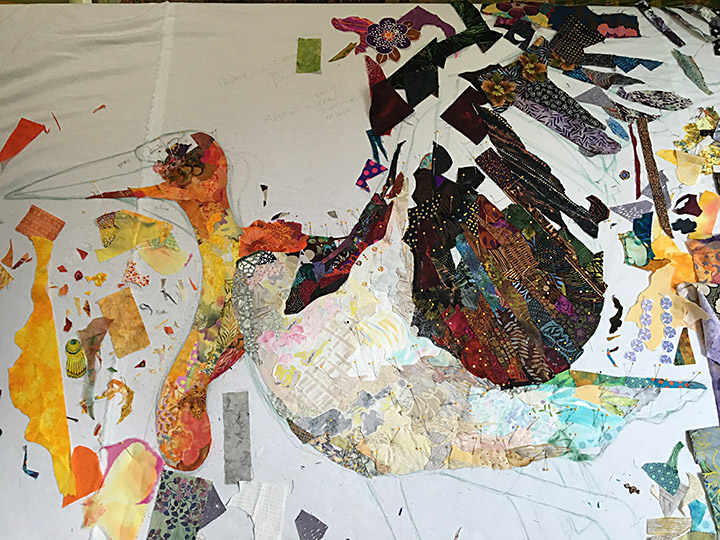
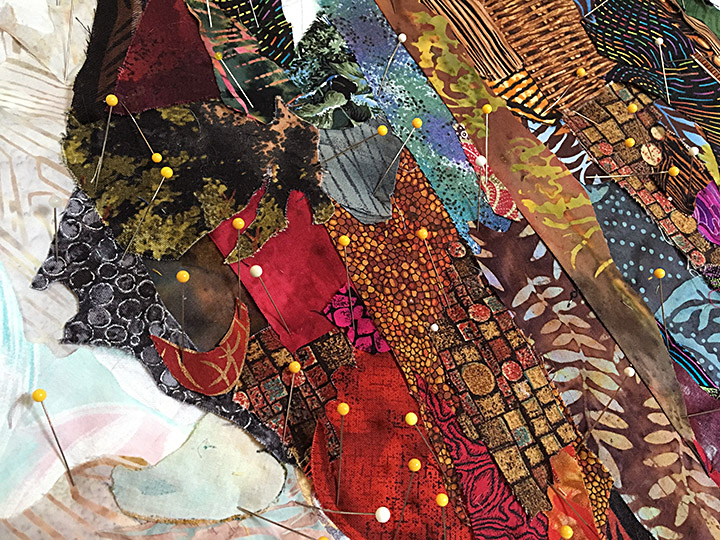
Students will sometimes ask me, “When do I glue?” Really you can do that anytime, though I usually wait until I’ve got several pieces of fabric pinned in place. When I’m on a creative roll, I glue when I run out of pins.
My Djinni cat will also tell me when to glue or to take a break. She leaps onto my lap, yes those are her claws kneading through my t-shirt. Sometimes she settles down, sometimes she pounces on the pins and rearranges the fabric pieces, all the while purring.
And my mom, who lives next door, stops in to keep me company as well. She helps me with projects—like sewing shut some new pillow cases or even the binding and casing for a 22-foot long crocodile quilt! Come to think of it, I’ve got some more casings to sew on the exhibit quilts. Who ya gonna call? My Mama!
After a break of a few days for a family kayak camping trip, I came back and looked at Oscar with fresh eyes. One thing I had considered, I now decided to do: open his beak. So I re-drew his head with mouth open and head pulled back with a nice curve to the neck, based on one of the original photos.
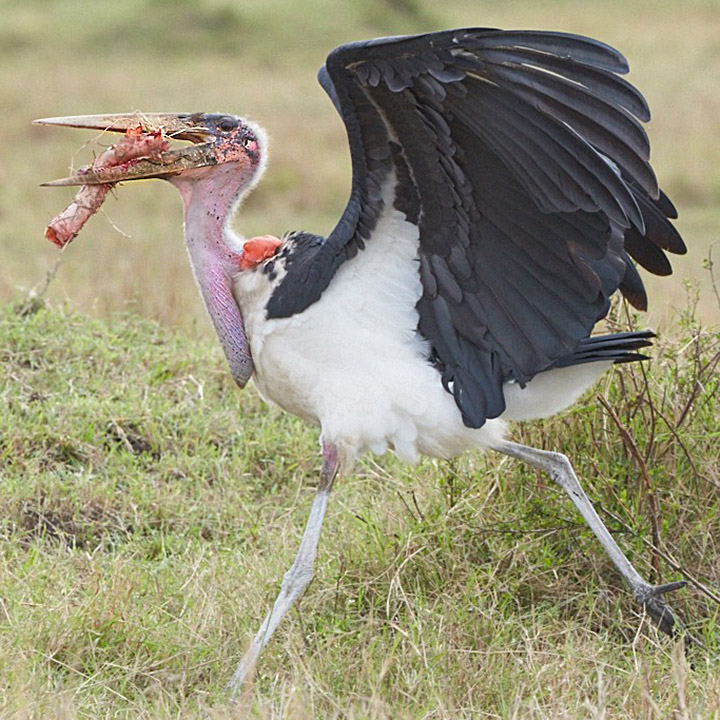
I had already glued those head and neck fabric pieces, but since it was only a thin smear of glue (see “Why Glue?”), I could pull them up and re-position most of them. Wouldn’t want to waste those perfect little pieces!
While rummaging in my fabric scrap suitcases, I scored a handful of “Tickled Pink” remnants from 10 years ago. Since I had yet to decide what color the beak was to be, pink it became. I love that this scrappy bird has bits and pieces of my other animal quilts in him. Among other scraps, a little bit of light pink from Djinni’s portrait in “Golden Temple of the Good Girls” is on his upper beak.
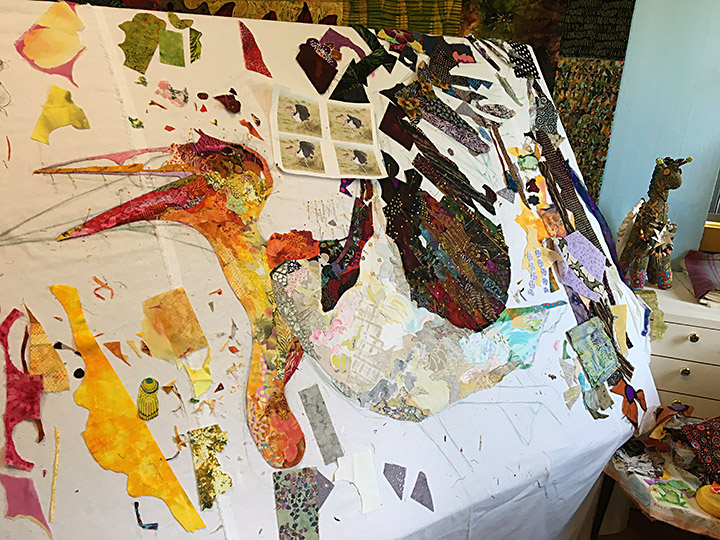
I enjoy seeing the personalities of my quilted creatures develop. Once I opened Oscar’s mouth, he seemed to develop a lot more character. He almost looks like he laughing. (Of course in the photo I’m working from he’s swallowing a huge wad of scavenged meat.) Imagining my subjects’ personalities helps me make decisions farther along the process, such as “What am I going to do in the background?” Hmmm, gonna have to trust the process on that one, too. I’ve stashed a few green scraps above his head for safe keeping. Green could work, but I haven’t figured out his “story” yet. Maybe he’ll tell me about it in the next few weeks. After all, he’s got a mouth now.
————
To read more click on these links to the other posts in the making of this quilt:
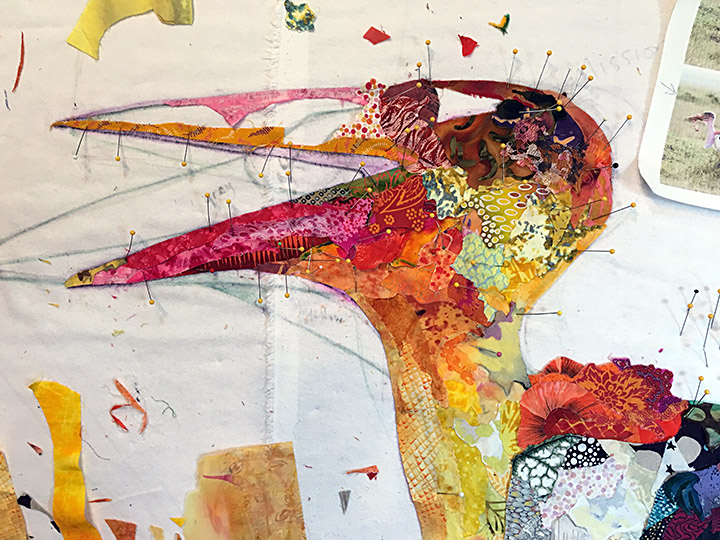












I love that you are sharing your creative process of your “STORK STORY”. I would never be able to take one of your classes – live currently in Saudi Arabia where a class such as this would be rare. It has made a difference that mid project you made the decision to leave the beak open, it tells a story that he just flew in and now his mouth is open for his supper. It gives it more of a sense of action rather than being static. Look forward to future posts.
Just amazing, I love watching you work.
Thank you for sharing your work. I look forward to it each week.
What a treat to be able to follow your creative process. thank you from all of us who cannot get to any of your classes.
Love to see Oscar emerging- really appreciate your taking time to share this. I love his beautiful neck and belly, will be neat to see him progress.
Amazing process! Thank you for sharing! I want to make a collage quilt and can’t believe that by Google searching “collage quilts” I was introduced to you and a giant croc and a whole new world has opened up! I ordered your books immediately, chose a photo and am anxiously awaiting news that your online class is available! I am forging ahead with a first draft today!
Susan, I enjoy receiving these e-mails from you! What a thrill to see your art works in progress and get an idea of your thought process as you create. That you for sharing!
Great article – love the step by step photos! Thanks for sharing, your process is inspiring and fascinating to watch. I am excited to see Oscar finished and view him at Houston. I love his mouth open, it does give him more character.
Hi Susan, loved this new post and am loving the new animal – looking forward to seeing all 11 in Houston. I wanted to send a picture of my work that I started at Quilting Adventures last April in Texas. I have worked on it off and on every since then, including taking the pieces back down to the muslin in places but am happy with the outcome and looking forward to the next challenge. I’ve done quite a few fish in the mean time but just consider them fun, especially when I create the whole fish from different parts of only one fabric. My two granddaughters, pictured in my work, have done fish too. Thanks for a fabulous class. Dot Collins
Lovely i am also in to birds h-artstudio.fr
Thank you so much for sharing your process. I hope to start fabric collage soon!
It’s fascinating to watch your process! Sew glad you started this blog!
Rock on Oscar!!!
love seeing Oscar come to life – I feel so lucky to be able to watch your work progress – you are so amazingly talented !